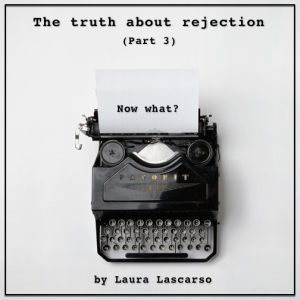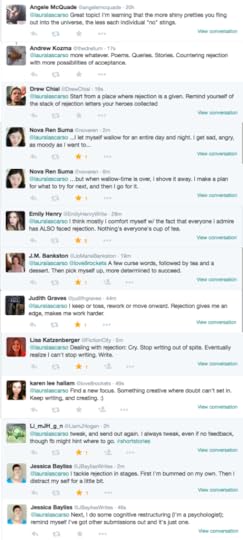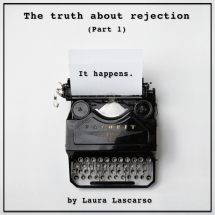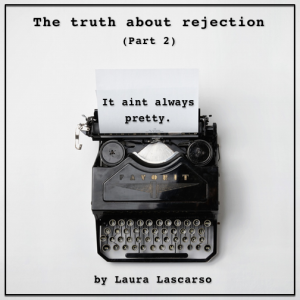Hannah R. Goodman's Blog, page 15
July 9, 2015
Questions to ask yourself when you feel
Questions to ask yourself when you feel like giving up. #amwriting #writerslife #writeotdie #publishing http://ow.ly/PnYhN @lauralascarso


Final installment #writerslife #rejectio
Final installment #writerslife #rejection #selfpublishing #amwriting The Truth About Rejection http://ow.ly/PnXEZ @lauralascarso


The Truth About Rejection: Part 3 (Now What?)
So what happens when the industry rejects you or you reject the industry? What is a writer to do when  no major publishing house wants to sign them, for whatever reason. Twenty years ago, there wasn’t much you could do but lick your wounds and try again, but nowadays, we have this thing called the Internet which has given rise to the self-published author and a myriad of small presses, both in print and online.
no major publishing house wants to sign them, for whatever reason. Twenty years ago, there wasn’t much you could do but lick your wounds and try again, but nowadays, we have this thing called the Internet which has given rise to the self-published author and a myriad of small presses, both in print and online.
A quick True/False quiz:
1. Self-published books are vanity publications.
FALSE. Many self-published authors are professionals with other projects published by mainstream media. Many authors, especially those with large followings, choose the self-published route because of the artistic freedom, fast turnaround and increased share of the profits.
2. Self-publishing is easy!
FALSE. Self-publishing is neither easy nor necessarily inexpensive. Any project worth its cover price should have been professionally edited and formatted for e-book and print with an eye-catching cover. Unless you’re an expert in several fields, you’re going to need to pay someone to do some or all of those things. The costs quickly add up.
3. Self-publishing is lucrative.
MAYBE. Like any venture, you get out of it what you put into it. If you simply put a book up on Amazon and sit back to let the profits roll in, you’ll be sitting there for a while, broke. You still need to promote your work, build a fan base, outreach, and build relationships in the reading community. All those things that a publisher may do for you or in conjunction with you, you must do yourself.
4. Self-published authors can earn enough to make a living.
TRUE. Some self-published books go on to be bestsellers by mainstream media. Some self-published authors make enough profit from their books to quit their day job and isn’t that the dream of all artists?
Speaking of dreams, we can’t talk about rejection without also talking about expectations. When I started out, I had visions of fat gold stickers, movie deals, and the New York Times Bestsellers list. I still have those dreams, but in the meantime, I set goals that are within reach and under my control. If you’re consistently falling short of your goals as an artist, maybe it is time to adjust your expectations for yourself.
These are the questions I ask myself:
Is what I’m doing making me happy?
Is it important?
Is there anything I’d rather be doing?
When I ask myself these questions, everything else becomes somewhat irrelevant. I’m an artist. My medium is the written word. I write fiction, specifically in the YA genre because I identify with those readers more than any other. I will always write in some capacity because it’s good for my mental health. I’ve got many more years to produce great stories. I will endure many more rejections. One day, I’ll make it.
Or maybe, I already have.
Maybe you have too.
Laura Lascarso is the author of RACING HEARTS, an e-novella series, which tells the story of two star-crossed lovers set in the world of competitive car racing. Her debut YA novel COUNTING BACKWARDS, which deals with mental illness, won the Florida Book Award gold medal for YA literature in 2012. Laura lives in North Florida with her two children, darling husband and a menagerie of animals. Follow her on Twitter @lauralascarso


July 5, 2015
“#writerslife #writers #writersproblems
“#writerslife #writers #writersproblems Looking for a home for article about how #socialmedia can kill a writer’s spirit.”


July 2, 2015
#Rejection #Publishing #Writing #YALit R
#Rejection #Publishing #Writing #YALit Read this! http://ow.ly/P5Q4L @lauralascarso @dawnEwebber @TheYAGuy @kacimari @StephanieKeyes


@lauralascarso 2nd Post about #Rejection #AmWriting #AmSu...
@lauralascarso 2nd Post about #Rejection #AmWriting #AmSurviving #amblogging #YAWriters #YALit #jointheconversation http://ow.ly/P5OrF


The Truth About Rejection: Part 2 (It Aint Always Pretty)
I used to take it personal.
I say that like my Vulcan heart is now calloused and impervious to rejection, but that is simply not true. Rejection hurts, in whatever form, whomever it comes from, and with whatever it entails. Unfortunately, part of being human is caring what other people think of you and our creative work is largely an extension of ourselves.
When I get a rejection, usually in the form of an email, I get bummed for a few hours, distract myself with some activity where success is assured (cleaning the bathroom), then work on an entirely unrelated project. But to give the range of experience I put out an APB on Twitter and received some reactions from my writer peeps.
 When asked how they cope with rejection, none of these writers said “Rejection? I’ve never been rejected.” Nor did they say they give up. Nor did any of them act as if rejection was an uncommon phenomenon.
When asked how they cope with rejection, none of these writers said “Rejection? I’ve never been rejected.” Nor did they say they give up. Nor did any of them act as if rejection was an uncommon phenomenon.
Now here’s the truth about publishing. It’s a business. The publisher’s job is to take your creative work and package it into a product they can sell. And like all businesses, publishers exist to turn a profit. In every major publishing house and in the small ones too, there are folks in the back room crunching numbers, conducting cost-benefit analysis, and doing number things that are generally foreign to us creatives who believe literature is a sacred art and the only thing a book needs, is to be well written and compelling in order to thrive. Agents, by extension, need to sell your story in order to make a living wage.
What this means is that if an editor doesn’t think that your book has either bestselling or award-winning potential, even if they loved it, they may not sign you. Or, if the publisher has titles that are similar by authors who’ve been with them longer, they may not sign you. Or, if they think your work is too controversial, cutting edge or nuanced, they may not sign you.
The point I’m trying to make, is that when rejection happens, it may be for reasons that are entirely out of your control and quite frankly, have little to do with your actual story.
Rejection might also mean that your story’s not ready for publication. If an editor gives you real feedback that you can incorporate into a revision, thank them genuinely. Some editors and/or agents will offer to do another read after you’ve revised. Save those contacts and revisit them later. Clearly, they saw something promising in your work and are interested in continuing the conversation.
Rejection generally falls into one of these categories:
Vague and somewhat disinterested: This rejection offers no real feedback or promise of future dealings. This rejection is the easiest to discount because the rejection is so nebulous that you can’t even be certain that the editor/agent read your project.
Pointed, detailed and constructive: Gold! This is free advice from a professional and can be used for future revisions. These rejections are especially useful if they include an invitation to resubmit later.
Mean-spirited and/or snarky: Save these for future laughs when you’re sitting on a pile of money and accolades. These folks are either burned out by the biz and in need a vacation or they’re frustrated creatives who receive pleasure by tearing others down. Don’t bother querying them again and warn your friends.
Crickets: Silence is a rejection of sorts, but the truth is that editors and agents receive exponentially more queries than they can accept and sometimes even respond to. Therefore, make sure you do your homework and take the time to really hone your pitch and query to specs so that yours is not easily dismissed.
Now that we’ve explored some methods for dealing with rejection, stay tuned for the last installment, The Truth About Rejection: Part 3 (Now What?)
Laura Lascarso is the author of RACING HEARTS, an e-novella series, which tells the story of two star-crossed lovers set in the world of competitive car racing. Her debut YA novel COUNTING BACKWARDS, which deals with mental illness, won the Florida Book Award gold medal for YA literature in 2012. Laura lives in North Florida with her two children, darling husband and a menagerie of animals. Follow her on Twitter @lauralascarso


June 25, 2015
Welcome @lauralascarso ! “The Truth Abo
Welcome @lauralascarso ! “The Truth About Rejection” http://ow.ly/OMeZK @StephanieKeyes @kacimari #amwriting #YALit


Welcome @lauralascarso ! “The Truth Abo
Welcome @lauralascarso ! “The Truth About Rejection” http://ow.ly/OMeZK @StephanieKeyes @kacimari #amwriting #YALit


The Truth About Rejection: It Happens
“The road to publication is long and fraught with frustration.” –Virgil Suarez
Suarez
This was what the award-winning poet and writer said to me 15 years ago when I had just finished my first full-length manuscript and was beginning to query agents.
Poor guy, I thought, life has really put him through the ringer.
For me, things would be different. Getting published would be simple: send out my query letter to a handful of agents, receive an immediate and overwhelming clamor for representation. Pitch that puppy and let the bidding wars begin.
Ha!
Maybe that was your experience. Good for you! Mine turned out to be very different. After querying 50+ agents with my first novel, then my second and then my third, I finally found a home with Caryn Wiseman of Andrea Brown Literary. After a much-needed rewrite on what would eventually become my debut novel COUNTING BACKWARDS (CB), Caryn pitched it to editors and hallelujah, one of them wanted to turn it into a real, live book.
A quick timeline: CB was written in 2007, agented in 2008, sold in 2009, rewritten several more times in 2010-2011 and debuted in the fall of 2012.
The next step was for me to focus on my next masterpiece, right? Wrong.
One of the biggest mistakes I made as a debut author was thinking that my work ended when I sent off my final revisions to my editor. I didn’t have a “platform” or a “brand.” I didn’t have followers. I didn’t even have a Facebook page. I was relying on the old model which said that writing was the author’s job, selling was the publisher’s job. I began focusing on my second and third novels shortly after completing CB. I wanted to have something in the hopper when CB went on to become a wild success.
Turns out, having a rock star agent and a contract with a major publisher does not guarantee success.
Now I’m going to be honest with you, maybe too honest. CB was projected to sell 20,000 copies. At least, that’s what my advance accounted for. As of today, nearly three years later, CB has sold a total of 1,000 copies. I will probably never receive royalties for CB and my major publisher is not clamoring for more literary genius from Laura Lascarso, sadly.
There was a point in February of 2013 where I considered hanging up my literary beret. I was talking it over with my husband, the time share between my job (the one that pays), family, and writing, and asking myself whether all the time I devoted to writing, rewriting, and publicizing my work could be put to better use elsewhere.
The next night I received an email that CB had won the Florida Book Award gold medal for YA literature. I thought it was a spam email and nearly deleted it, but turns out, it was true. While winning the award didn’t grant me more money or necessarily even more readers, it was a sign from the universe that I was on the right path.
Now for some inspirational stories of rejection:
Stephen King, living in a doublewide, writing in the laundry room, getting manuscripts rejected left and right. At one point he threw CARRIE in the trash saying, “So I threw it away… After all, who wanted to read a book about a poor girl with menstrual problems?” Carrie was retrieved from the garbage by his astute wife and went on to get rejected 30 more times before finding a publisher and launching King’s career.
JK Rowling, single mom, writing Harry Potter in a café, living on government benefits. HARRY POTTER AND THE PHILOSOPHER’S STONE was rejected by 12 publishers before finding a home with Bloomsbury. Then, after becoming a raging success, JK went querying again for her adult detective novel under pseudonym Robert Galbraith and publishers rejected her AGAIN!
The first installment of Cassandra Clare’s THE MORTAL INSTRUMENTS series was turned down by publishers because one of the main characters is gay and embarks on a relationship with another male character. Publishers mistakenly thought teens couldn’t handle homosexuality, but that’s a topic for another post…
So what does this tell us, other than opinions are like elbows and you are never too rich and famous to be rejected? It tells us that if any of these authors had quit when they were down, they’d never have become the household names that they are today, nor would their books have graced our literary consciousness. And for every success story there are exponentially more stories of authors, still struggling, still writing in obscurity, still putting out work in whatever capacity they are able because they are artists and nothing else satisfies like the act of creation.
Now that we can acknowledge that rejection exists, please stay tuned for my next installment on how we as creators cope with rejection in next week’s installment, The Truth About Rejection: Part 2 (It Aint Always Pretty).
Laura Lascarso is the author of RACING HEARTS, an e-novella series, which tells the story of two star-crossed lovers set in the world of competitive car racing. Her debut YA novel COUNTING BACKWARDS, which deals with mental illness, won the Florida Book Award gold medal for YA literature in 2012. Laura lives in North Florida with her two children, darling husband and a menagerie of animals. Follow her on Twitter @lauralascarso






